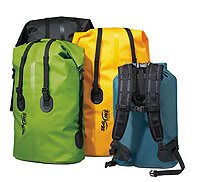-
Posts
367 -
Joined
-
Last visited
Content Type
Events
Profiles
Forums
Store
Posts posted by dannyboy
-
-
We had the the same problem with dry rot and a seat collapsing, when I pulled the gunwales off I found the dry rot was considerable. It took about 12 hours to replace them in our Bluewater canoe, starting with rough boards - jointing, planeing, sizing, splicing, routing, sanding, finishing and installing.
I like wood and working with wood, but if I had to do it again I would go with aluminum gunwales for the less maintenance factor, after 20 years a $350 investment is not bad especially when you figure the new Kevlars go for around $3000.
Dan
-
What Wayne said - remove rivets, reseal the joints and replace the rivets - if you need help to either buck or drive rivets let me know; us rotor wing mechanics work for beer rather than money.
Dan
-
All the best to you and your family Wayne - you could certainly use a break but Jen doesn't sit around and feel sorry for herself; certainly an incredible woman.
Dan
-
This part is the race:

It should be replaced when you replace the bearing and it sits inside the hub, usually pressed in.

Dan
-
I'd say Heinz
but
Occam's razor says its a Shepherd crossed with Lab.
Dan
-
Yes I stayed up and watched the landing - amazing technology, I am glad the USA believes in doing things like this.
Dan
-
With the smoker full it will take longer to get up to temperature so leave some extra time.
Make sure the heat can circulate so you don't get any cool spots.
Rolling the ribs can help to fit more in the smoker:

Dan
-
Peak vice is a good value, $150 new for the rotary.
Dan
-
If Lake Erie is up the launch at Port Maitland can be difficult, you can launch at Fishmaster's just outside Dunnville it used to be $5 with parking - they will be able to put you on fish in the river or the lake if it turns out decent.
Dan
-
I used Icky Fly Works before I started tying, Free shipping for orders over $30 and $1 per fly on average seemed decent.
Dan
-
Butterfly stitches (Steri-strips) are better than crazy glue (and hurt much less when a real Dr has to tear the glue off to correctly stitch you up) and much more hygienic than do-it-yourself stitches.
Dan
-
Lots of great info here, a waterproof portage type pack is a good thing to have:

Keeps your gear dry, they normally float and make life easy. Mountaineering type packs that are tall and skinny with stuff tied on the outside are a pain, fumbling with several items like paddles, fishing rods, sleeping bags in garbage bags and so on looses its appeal after the first portage.
Clipping your PFD to the stern seat when you portage keeps the canoe nose up.
Don't bother with a saw or axe, you can always collect enough firewood from beaver dams or along the shore.
Double check when you are leaving a portage for gear, after a couple portages someone generally forgets a paddle leaned against a tree or sunglasses on a rock after a meal.
Water is heavy bring a filter/purifier system if the water is not safe. A can of beans weighs a pound, we figure a pound of food per person per day (three meals), but don't bother with the expensive dehydrated stuff you see at camping stores. There is a good selection of single pot meals at you local supermarket where you just add water and cook - noodles, rice, curries, scalloped potatoes and so on that are great for meals and are light to carry.
Dan
-
2 cans bans your choice - I like to mix black and kidney
2 cans Tomatoes
1/3 lb. smoked pork - strips bacon, pork hock, ham
1 onion
3-4 garlic cloves
2 split and seeded jalapeño or serrano peppers
3/4 cup of your favorite BBQ sauce
1 Tbsp. dry mustard
1 Tbsp. Worcestershire sauce
1 Tbsp. chili powder
salt and pepper to taste
Sauté onions and garlic in heavy dutch oven, add everything else and place the dutch oven in a smoker with lid off for at least 2 hours at 200F. You can also go indirect on a gas grill using a smoke box. If they start to dry out add a bit of beer or water to keep them liquid.
If using pork hocks remove and debone when cooked and add the meat back into the beans.
If you're feeding women, children, or Liberals you can use only half of the hot peppers.
Dan
-
You need the Landowner to give you permission for access and hunting.
Dan
-
Well done, nice tasty haul.
Dan
-
Thanks for sharing Mike, great memory to have for sure. Back then my standard canoing gear was jeans, flannel shirt and canvas high tops.
Hmm... Ides of March 1965 makes you one week older than me, still got a few portages left but my back sure was glad when Kevlar replaced canvas/cedar strip and nylon replaced the canvas tent.
Dan
-
Hard to beat the 336 in 30-30 for a bush gun, they are a good value used and the older ones seem smoother to me or maybe they are just broken in.
From a stand you might be better served with a flatter shooting bolt rifle.
Either way buy a .22 for practice, ammo is cheap and you will learn better sight and trigger control without noise and recoil.
Guns are like fishing rods, not one can do everything and after a while you own several - slippery slope.
Dan
-
Well I followed Fish Farmer's advice, skin on, dipped in flour, egg wash then crumbs - turned out fantastic - Thanks.
Dan
-
I offered to cook supper tonight at the inlaws; deep fry perch they got from Sobeys. The fillets have the skin on, I have always cooked them without skin because that is the way I fillet them.
Do I need to skin them or can I cook them with the skin on and is the skin usually eaten?
thanks,
Dan
-
The best way to know is to pull the bearings and have a look, as stated before it is cheap insurance. It doesn't take long and if you haven't done it before you learn a new skill and it can be done at your convenience rather than wherever it fails.
I am a 'preventative maintenance' kinda guy rather than a 'if it ain't broke leave it' type though.
Dan
-
-
Big Agnes is my favorite for spring, summer and fall;
If you are winter camping go the Exped recommended above, they are a bit more work to inflate but no big deal.
Dan
-
Solo's advise is great, WF lines are easier to learn how to cast. Current lines are hard to wear out especially if taken care of.
To answer one of your questions above, yes you use the entire fly line. On average fly lines are about 90 feet long and have a profile as below:

Check out some videos on-line to give you an idea about fly casting as it is different from bait or spin casting in that the line carries the lure (fly) rather than the lure carrying the line.
You should be in for some great top water action on Lake St Clair.
-
Very enjoyable, thanks for sharing this.
Dan



Replacing ash gunnels on canoe
in General Discussion
Posted
We used tung oil on our first set of gunwales and it was stored right side up in the roof of the garage, they also turned black like you mentioned.
On the replacement set I used marine spar varnish (Epiphanes) I scuff and add a new coat each year and so far after 3 years they still look good.
Dan